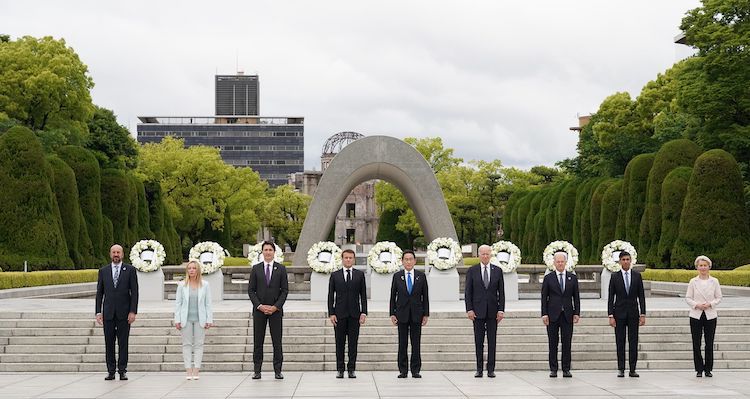Photo: Wreath-Laying at the Cenotaph for the Atomic Bomb Victims by G7 leaders—Italy’s PM Meloni, PM Trudeau of Canada, President Macron of France, Summit host Fumio Kishida, US President Biden, and Chancellor Scholz—flanked by European Commission president von der Leyen (right) and European Council president Michel (left). Credit: Govt. of Japan.
By Ramesh Jaura
BERLIN | TOKYO, 11 June 2023 (IDN) — Peacebuilder and Buddhist leader Daisaku Ikeda, who is president of the Tokyo-based Soka Gakkai International (SGI), issued a statement ahead of the meeting of the Group of 7 (G7) countries in Hiroshima May 19-21, calling on the G7 leaders to take bold steps toward resolving the conflict in Ukraine and guarantee the security of all humanity by taking the lead in discussions on pledges of No First Use of nuclear weapons.
The venue of the summit of seven leaders—from Canada, France, Germany, Italy, Japan, the United Kingdom and the United States, plus the European Union (EU)—was symbolically stark because the US atomic bombings in 1945 killed over 226,000 people in the twin Japanese cities of Hiroshima and Nagasaki, with the heaviest toll in Hiroshima.
But did the seven leaders—from Canada, France, Germany, Italy, Japan, the United Kingdom and the United States, plus the European Union (EU)—manage to take bold steps in respect of the Russia-Ukraine conflict and committing to ‘No First Use’ of nuclear weapons?
IDN interviewed Mr Hirotsugu Terasaki, Director General of Peace and Global Issues, Soka Gakkai International. Following is the complete text of the interview:
Q: What does the SG think of the outcome of the Hiroshima Summit, which ended May 21 with Ukraine in focus and both Russia and China criticizing the G7?
Hirotsugu Terasaki (HT): Hiroshima, where the first atomic bomb in human history was dropped, is the starting point of peace, and a summit meeting for the total abolition of nuclear weapons should be held there—the this is something SGI President Daisaku Ikeda has repeatedly called for since 1975.
Although it is difficult to say that this summit meeting made concrete progress toward nuclear disarmament, I think it is still significant that the G7 leaders met in Hiroshima, a place that symbolizes the catastrophic effects of nuclear weapons, and that these leaders directly listened to the experiences of hibakusha and felt first-hand the reality of the atomic bombing.
The leaders issued a communiqué, but what truly matters is proactive steps to tackle the current global crisis. I strongly hope that each country will promote open dialogue for a peaceful world, transcending barriers of ideology and interest.
Q: What has the Hiroshima Summit, in the view of SG, achieved in regard to a cessation of hostilities between Russia and Ukraine? Have they developed concrete plans for negotiations?
SGI
HT: Above all, the prevention of catastrophic consequences is the ultimate wish of the world’s people and the responsibility of national leaders.
Unfortunately, I do not think that the Summit fully developed concrete plans for negotiations toward a ceasefire, while it expressed support for Ukraine and condemnation of and strengthening of sanctions against Russia. However, I do welcome the strengthening of cooperation with the Global South.
We will continue to call for all concerned parties to create space for deliberations toward full cessation of hostilities to prevent more suffering as a result of the conflict.
Q: Have the G7 committed at the Hiroshima Summit—as Dr Ikeda urged—to taking the lead in discussions on pledges of No First Use of nuclear weapon, which is a “prescription for hope” and can serve as the axle connecting the twin wheels of the NPT and TPNW, speeding realization of a world free from nuclear weapons.
HT: No tangible results have been seen. But I would like to believe that seeds have been planted. We should take a realistic step forward so that future generations will look at this moment and say it was a turning point of the times.
The NPT and the TPNW have a common goal of realizing a world without nuclear weapons. With the risk of the use of nuclear weapons being unprecedently high and protracted, a commitment to No First Use by the nuclear weapon-states is the foundation for preventing their use. It couldserve as a common basis linking the NPT and the TPNW, and we will continue to urge the G7 nations to take the lead in discussions on pledges of No First Use of nuclear weapons.
Q: Have the G7 countries succeeded in communicating powerfully to the world from Hiroshima “the animating spirit of the Treaty on the Prohibition of Nuclear Weapons (TPNW)”, reflected in G20 member countries’ officially expressed recognition that the use or threat of use of nuclear weapons is “inadmissible“.
HT: It is noteworthy that the G7 leaders issued the Hiroshima Vision for Nuclear Disarmament and confirmed the G20 Bali Declaration.
Humanity will continue to stand on a precipitous ledge that could collapse at any moment, unless we change the approach of nuclear deterrence based on the premise that other countries’ nuclear weapons are dangerous, while one’s own are the foundation of security. This keen sense of crisis led to the adoption of TPNW, with the support of A-bomb survivors and civil society. Its universalization is increasingly essential.
We will continue to expand awareness of the inhumane nature of nuclear weapons at the grassroots throughout the world so that negotiations to overcome the current reality can move forward based on pledges of No First Use. [IDN-InDepthNews]











